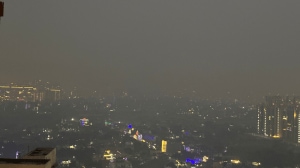Decode Politics: Why are anti-CAA protests confined to Assam, Tripura in Northeast
Arunachal, Nagaland, Mizoram, Manipur have Inner Line Permit; Meghalaya has Sixth Schedule. But most of Assam, Tripura — which share long, porous boundaries with Bangladesh and are most affected by migration — have neither
 Members of All Assam Students Union (AASU) take part in a protest march after the central government notified the rules for implementation of the Citizenship (Amendment) Act, 2019, in Guwahati. (PTI Photo)
Members of All Assam Students Union (AASU) take part in a protest march after the central government notified the rules for implementation of the Citizenship (Amendment) Act, 2019, in Guwahati. (PTI Photo)With the recent notification of rules for the implementation of the Citizenship (Amendment) Act or CAA — the passage of which had rocked the Northeast in 2019 — there are loud voices of dissent against it, but this time only in Assam and Tripura.
This is because nearly all areas of the Northeast, barring large swathes of these two states, have effectively been exempted from the provisions of the CAA, which enables easing of citizenship to Hindu, Sikh, Buddhist, Jain, Parsi or Christian migrants from Pakistan, Bangladesh and Afghanistan, who entered India before December 31, 2014.
The Act states that this provision shall not apply to “tribal areas of Assam, Meghalaya, Mizoram or Tripura, as included in the Sixth Schedule of the Constitution, and the area covered under ‘The Inner Line’ notified under the Bengal Eastern Frontier Regulation, 1873”.
What is the Inner Line system?
An Inner Line Permit (ILP) regime is operational in the four Northeastern states of Arunachal Pradesh, Nagaland, Mizoram and Manipur. The ILP is a special permit that residents of other parts of India need to apply for and receive, in order to enter and spend any duration of time in these states. Initially introduced by the British via the Bengal Eastern Frontier Regulation 1873 for the tribal hill areas of the region, the system continued into the post-Independence period with the stated aim “to prevent settlement of other Indian nationals, in order to protect the indigenous/tribal population”.
Significantly, this system was in place in only three states — Arunachal Pradesh, Nagaland and Mizoram — with Manipur brought under its ambit only in January 2020, following protests in the state after the CAA was enacted.
What is the Sixth Schedule?
In the Northeast, the Sixth Schedule of the Indian Constitution provides special powers to autonomous district councils (ADCs) in Assam, Meghalaya, Tripura and Mizoram, which have jurisdiction over specific tribal-majority areas, with the objective of ensuring development and boosting self-governance by tribal communities in those pockets.
Of the seven sisters in the Northeast, Mizoram is already outside the CAA ambit as the ILP is operational there. All of Meghalaya, barring a small part around Shillong, comes under three different ADCs — one each for the Khasi, Garo and Jaintia hills. Assam has three ADCs under the Sixth Schedule — the Bodoland Territorial Council that covers five districts; the North Cachar Hills Autonomous Council that covers one district; and the Karbi-Anglong Autonomous District Council that covers two districts. Similarly, Tripura has the Tripura Tribal Areas Autonomous District Council.
Despite most of Meghalaya coming under the Sixth Schedule, there still is some discontent among groups like the opposition Voice of the People’s Party, which is against the implementation of the CAA in areas not under the Sixth Schedule. Already, the Meghalaya government is pushing for the implementation of an ILP regime across the state, which would make the CAA redundant.
Why are Assam, Tripura against CAA?
Most of Assam (which shares a 263-km border with Bangladesh) and Tripura (which has a 856-km border with Bangladesh) does not come under either the Sixth Schedule or the ILP regime. And that is why there’s unrest in these areas against the CAA.
Anti-immigrant sentiment is strong in both states, which share long, porous borders with Bangladesh, and have had streams of refugees coming in from the neighbouring country from before the time when it was known as East Pakistan. There is no record of these migrations; neither of the large-scale ones around the times of great upheavals — India’s Independence and Partition in 1947, the creation of Bangladesh in 1971; nor of the steady trickle that has continued since then. Although some of these refugees/migrants are Muslim, a majority are believed to be Bengali-speaking Hindus.
Not only does the CAA conspicuously omit Muslim refugees/migrants from its ambit, it also promises to legitimise Hindu refugees/migrants. Thus, it falls foul of Assamese ethno-nationalists, and increasingly, Tripuri tribals, who feel threatened by the rising number of Bengali speakers.
With the Centre now professing to delink the CAA from the National Register of Citizens (NRC) — to weed out illegal immigrants, which was originally conceived for, and only implemented in Assam, but remains stalled — many in Assam feel the CAA undermines their main ideological and electoral plank. It is somewhat similar in Tripura.
Hence, the protests in both states.






- 01
- 02
- 03
- 04
- 05

























